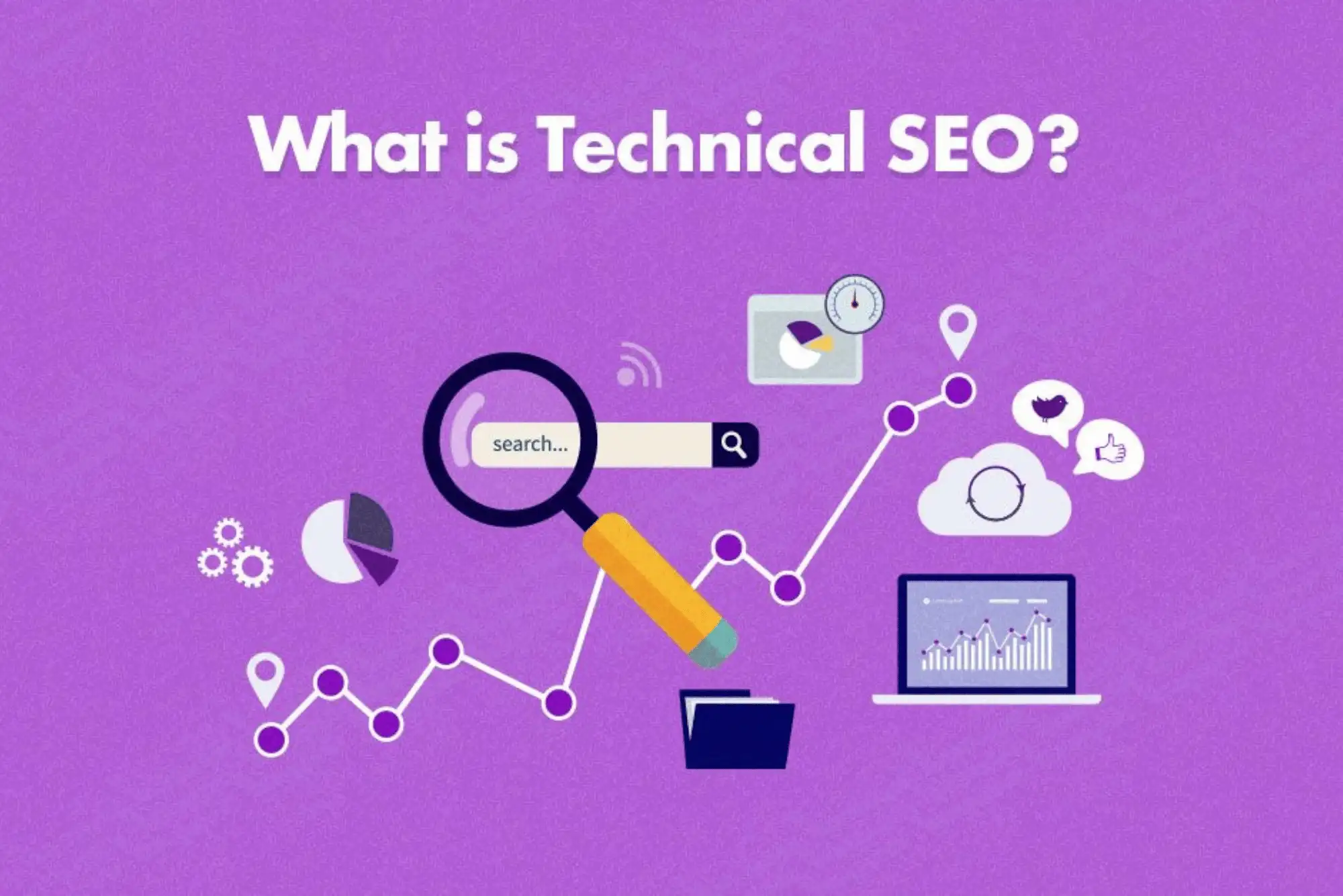In the vast landscape of digital marketing, where visibility reigns supreme, understanding the intricacies of Technical SEO is indispensable. If you’ve ever pondered, “What is technical SEO?” fear not, for this article serves as a beacon of enlightenment in navigating this crucial aspect of online success.
Fundamentals of Technical SEO
Technical SEO serves as the backbone of any successful digital marketing strategy, underpinning the framework upon which websites thrive in the competitive online landscape. At its core, technical SEO revolves around optimizing the infrastructure and backend elements of a website to improve its search engine visibility and user experience.
Understanding the Significance of Website Structure
Central to technical SEO is the concept of website structure. A well-organized and intuitive architecture not only facilitates seamless navigation for users but also provides search engine crawlers with clear pathways to explore and index content efficiently. From hierarchical categorization to logical linking structures, website architecture plays a pivotal role in determining the discoverability and accessibility of your content.
Key Elements of Technical SEO
Technical SEO encompasses a myriad of critical components, each contributing to the overall health and performance of a website in search engine results. These elements include:
- Website Speed and Performance Optimization: Page loading speed directly impacts user satisfaction and search engine rankings. Technical SEO involves optimizing images, minimizing code, leveraging caching mechanisms, and employing Content Delivery Networks (CDNs) to ensure swift and seamless browsing experiences.
- Mobile Friendliness and Responsiveness: With the exponential rise in mobile searches, ensuring that your website is mobile-friendly is imperative. Technical SEO entails implementing responsive design principles, optimizing viewport settings, and prioritizing mobile user experience to cater to the growing segment of mobile users effectively.
- URL Structure and Canonicalization: A coherent URL structure not only aids users in understanding the hierarchy of your website but also assists search engines in determining the relevance of your content. Canonicalization, through the use of canonical tags, helps prevent issues related to duplicate content by specifying the preferred version of a URL.
- Indexing and Crawling Directives: The utilization of directives such as robots.txt and meta robots tags dictates how search engine crawlers navigate and index your website. By strategically configuring these directives, webmasters can control which parts of their website are accessible to search engines, thereby optimizing crawl budget allocation.
- XML Sitemaps: XML sitemaps serve as comprehensive guides for search engine crawlers, facilitating the discovery and indexing of website content. By regularly updating and submitting XML sitemaps, webmasters ensure that their entire website is systematically crawled and indexed by search engines.
- Schema Markup and Structured Data: Implementing schema markup provides search engines with additional context about your content, enabling them to display rich snippets and enhanced search results. By incorporating structured data into your website, you can improve visibility, click-through rates, and overall search engine performance.
- HTTPS and Secure Website Configuration: Securing your website with HTTPS encryption not only protects user data but also instills trust and credibility. Technical SEO involves obtaining SSL certificates, enforcing HTTPS redirection, and implementing robust security measures to safeguard sensitive information and enhance search engine rankings.
Understanding these fundamental elements of technical SEO lays the groundwork for implementing effective optimization strategies that enhance website visibility, user experience, and overall search engine performance. By prioritizing technical SEO best practices, webmasters can establish a solid foundation for success in the digital realm.
Core Components of Technical SEO
Enhancing Website Speed and Performance
Page loading speed directly impacts user satisfaction and search engine rankings. Technical SEO involves optimizing images, minifying code, leveraging browser caching, and employing Content Delivery Networks (CDNs) to expedite website loading times.
Embracing Mobile Friendliness
With mobile searches surpassing desktop queries, ensuring your website is mobile-friendly is paramount. Technical SEO involves responsive design implementation, optimizing viewport settings, and prioritizing mobile user experience to cater to this growing segment of users.
URL Structure and Canonicalization
A coherent URL structure aids both users and search engines in understanding website hierarchy and content relevance. Canonicalization further resolves duplicate content issues by specifying preferred URLs, preventing SEO dilution.
Indexing and Crawling Directives
Robots.txt and meta robots tags dictate which parts of your website search engines can crawl and index. Proper utilization of these directives ensures efficient crawl budget allocation and prevents indexing of undesirable pages.
XML Sitemaps
XML sitemaps serve as roadmaps for search engine crawlers, guiding them to discover and index website content systematically. Technical SEO involves regularly updating and submitting XML sitemaps to ensure comprehensive coverage of your website’s pages.
Schema Markup and Structured Data
Implementing schema markup enriches search engine results with additional context, enhancing visibility and click-through rates. Technical SEO involves integrating structured data to provide search engines with detailed insights into your content.
HTTPS and Secure Website Configuration
Securing your website with HTTPS not only safeguards user data but also augments search engine rankings. Technical SEO entails acquiring SSL certificates, redirecting HTTP to HTTPS, and ensuring robust security measures to instill trust and authority.
Advanced Technical SEO Techniques

Internationalization and Multilingual SEO
Expanding your online presence globally necessitates technical SEO strategies tailored to diverse linguistic and cultural landscapes. Implementing hreflang tags, geotargeting, and localized content optimization facilitates internationalization efforts.
Pagination and Infinite Scroll Optimization
Websites featuring paginated content or infinite scrolls require meticulous technical SEO considerations to ensure optimal crawlability and indexation. Implementing rel=”next” and rel=”prev” tags and managing canonicalization effectively mitigate pagination-related SEO pitfalls.
JavaScript SEO and Rendering
As websites increasingly rely on JavaScript for dynamic content presentation, mastering JavaScript SEO becomes imperative. Technical SEO entails employing server-side rendering, pre-rendering techniques, and ensuring compatibility with search engine crawlers to index JavaScript-rendered content accurately.
AMP (Accelerated Mobile Pages)
Accelerated Mobile Pages (AMP) offer lightning-fast mobile browsing experiences, bolstering both user engagement and search engine rankings. Technical SEO involves implementing and optimizing AMP versions of web pages to leverage this performance-enhancing framework.
Voice Search Optimization
The proliferation of voice-enabled devices has ushered in a new era of search behavior, demanding tailored technical SEO strategies. Optimizing for conversational queries, structuring content in a Q&A format, and leveraging featured snippets optimize your website for voice search.
Site Architecture and Internal Linking Strategies
A well-structured site architecture and internal linking framework enhance crawlability, distribute link equity, and bolster topical relevance. Technical SEO involves organizing content hierarchies, implementing breadcrumb navigation, and strategically interlinking related pages to amplify SEO efficacy.
Tools and Resources for Technical SEO

Google Search Console
Google Search Console serves as a quintessential tool for monitoring website performance, identifying indexing issues, and accessing invaluable insights into search visibility and user behavior.
SEO Crawlers
Robust SEO crawlers such as Screaming Frog and DeepCrawl facilitate comprehensive website audits, uncovering technical SEO issues, and providing actionable recommendations for optimization.
Website Speed Testing Tools
Tools like PageSpeed Insights and GTmetrix offer detailed performance metrics and optimization suggestions to enhance website loading speed and user experience.
Structured Data Testing Tool
Google’s Structured Data Testing Tool enables webmasters to validate schema markup implementation and preview rich snippets generated by structured data.
Mobile-Friendly Test
Google’s Mobile-Friendly Test assesses your website’s mobile compatibility and provides recommendations for enhancing mobile user experience and search engine rankings.
Security Testing Tools
Tools like SSL Labs evaluate website security configurations, identifying vulnerabilities and ensuring robust HTTPS implementation to safeguard user data.
Common Technical SEO Issues and Solutions
Technical SEO is not without its challenges, and webmasters often encounter various issues that can hinder website performance and search engine visibility. Understanding these common pitfalls and implementing effective solutions is crucial for maintaining a healthy online presence. Let’s delve deeper into some prevalent technical SEO issues and the strategies to address them:
Addressing Duplicate Content
Duplicate content can harm SEO efforts by confusing search engines and diluting the relevance of your web pages. Common causes of duplicate content include URL variations, printer-friendly versions of pages, and boilerplate content across multiple pages. To address this issue:
- Implement canonical tags to specify the preferred version of duplicate pages.
- Consolidate similar pages by redirecting alternate URLs to the canonical version.
- Use 301 redirects to redirect outdated or duplicate content to its canonical counterpart.
Resolving 404 Errors and Broken Links
404 errors occur when a requested page is not found, resulting in a poor user experience and potential SEO penalties. Broken links, both internal and external, contribute to this issue and can negatively impact crawlability and indexing. To resolve 404 errors and broken links:
- Regularly monitor website analytics and crawl reports to identify broken links.
- Implement 301 redirects to redirect users and search engines from obsolete URLs to relevant pages.
- Customize 404 error pages to provide users with helpful navigation options and encourage engagement.
Mitigating Redirect Chains
Redirect chains occur when multiple redirects are chained together, leading to unnecessary delays in page loading and diminishing link equity flow. Long redirect chains can hinder crawl efficiency and impact search engine rankings. To mitigate redirect chains:
- Audit your website’s redirect setup using tools like Screaming Frog or Google Search Console.
- Consolidate redirect chains by updating links to point directly to the final destination URL.
- Implement 301 redirects sparingly and avoid unnecessary redirections to streamline link equity flow.
Combating Thin Content and Low-Quality Pages
Thin content, characterized by low word count or lack of substantive information, can undermine SEO efforts and diminish user trust. Low-quality pages, including auto-generated content, doorway pages, and duplicate content, also pose challenges to search engine visibility. To combat thin content and low-quality pages:
- Conduct a content audit to identify and consolidate thin or low-quality pages.
- Enhance existing content by adding depth, relevance, and value to improve user engagement.
- Remove or noindex pages with little to no value to prevent them from being indexed by search engines.
Safeguarding Against Malware and Security Breaches
Malware infections and security breaches not only compromise website integrity but also pose significant risks to user data and trust. Malicious attacks can result in blacklisting by search engines, leading to plummeting rankings and traffic loss. To safeguard against malware and security breaches:
- Regularly update website software, plugins, and security patches to mitigate vulnerabilities.
- Implement robust security measures such as firewalls, SSL encryption, and malware scanning tools.
- Monitor website security alerts and conduct periodic security audits to detect and address potential threats promptly.
By proactively addressing these common technical SEO issues and implementing effective solutions, webmasters can optimize website performance, enhance search engine visibility, and foster a positive user experience. Regular monitoring and maintenance are essential to ensuring long-term success in the competitive digital landscape.
Best Practices for Implementing Technical SEO

Implementing technical SEO involves adhering to a set of best practices to maximize the effectiveness of optimization efforts and ensure sustained search engine visibility. Here are some key practices to consider:
Regular Website Audits
Conducting regular website audits is crucial for identifying technical SEO issues, monitoring performance metrics, and implementing optimizations. These audits should encompass aspects such as website speed, mobile-friendliness, indexation status, and security protocols. By proactively addressing issues discovered during audits, you can maintain a healthy website ecosystem that aligns with search engine guidelines.
Keeping Up with Search Engine Algorithm Updates
Search engines frequently update their algorithms to deliver more relevant and valuable results to users. Staying informed about these updates and understanding their implications for technical SEO is essential. By keeping pace with algorithmic changes, you can adapt your optimization strategies accordingly, ensuring continued search engine visibility and ranking performance.
Collaboration Between SEO and Development Teams
Effective collaboration between SEO professionals and development teams is vital for implementing technical SEO recommendations seamlessly. Clear communication channels, mutual understanding of objectives, and collaborative problem-solving facilitate the integration of SEO best practices into website development processes. By fostering synergy between these teams, you can expedite the implementation of technical optimizations and minimize potential conflicts or oversights.
Continuous Monitoring and Optimization
Technical SEO is an ongoing endeavor that requires continuous monitoring and optimization. Regularly monitoring key performance indicators, such as website traffic, rankings, and user engagement metrics, enables you to identify areas for improvement and capitalize on emerging opportunities. Iterative optimization efforts, informed by data-driven insights and industry best practices, contribute to the long-term success of your technical SEO initiatives.
Prioritizing User Experience
While technical SEO primarily focuses on optimizing websites for search engines, prioritizing user experience is equally important. A seamless user experience, characterized by fast loading times, intuitive navigation, and mobile responsiveness, not only enhances user satisfaction but also signals website quality to search engines. By optimizing technical elements with the user in mind, you can create a positive browsing experience that encourages engagement and fosters trust and loyalty.
Investing in Education and Training
The field of technical SEO is dynamic and constantly evolving, with new technologies, tools, and best practices emerging regularly. Investing in ongoing education and training for your team members ensures that they stay abreast of the latest developments in the industry and possess the skills and knowledge needed to execute technical SEO strategies effectively. Whether through formal training programs, industry conferences, or self-directed learning initiatives, continuous education empowers your team to drive continuous improvement and innovation in technical SEO practices.
By following these best practices and integrating them into your technical SEO strategy, you can optimize your website’s infrastructure and enhance its visibility, accessibility, and usability for both users and search engines.




